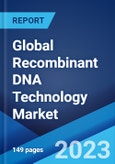The global recombinant DNA technology market size reached US$ 729.8 Billion in 2022. Looking forward, the market is expected to reach US$ 966.8 Billion by 2028, exhibiting a growth rate (CAGR) of 4.80% during 2022-2028.
The advent of recombinant DNA technology has revolutionized development in biology and offered new opportunities for innovations. Also known as genetic engineering, it is currently widely used to alter genetic material outside an organism and obtain improved and desired characteristics in living organisms. It includes the insertion of DNA fragments from several sources that have a desirable gene sequence through an appropriate vector. Besides this, it assists in the safe, affordable, and sufficient production of vital proteins required for dietary purposes and fighting health problems. As a result, it has multidisciplinary applications and a remarkable potential to improve health and enhance food resources and resistance to divergent adverse environmental effects.
The advent of recombinant DNA technology has revolutionized development in biology and offered new opportunities for innovations. Also known as genetic engineering, it is currently widely used to alter genetic material outside an organism and obtain improved and desired characteristics in living organisms. It includes the insertion of DNA fragments from several sources that have a desirable gene sequence through an appropriate vector. Besides this, it assists in the safe, affordable, and sufficient production of vital proteins required for dietary purposes and fighting health problems. As a result, it has multidisciplinary applications and a remarkable potential to improve health and enhance food resources and resistance to divergent adverse environmental effects.
Recombinant DNA Technology Market Trends
The recombinant DNA technology is utilized for improving different health conditions, mainly by developing new vaccines and pharmaceuticals. This, coupled with the improving treatment strategies on account of the developing diagnostics kits, monitoring devices, and new therapeutic approaches, represents one of the key factors impelling the growth of the market. Moreover, there is a rise in the research conducted on genetically modified organisms (GMO), which include microorganisms that are considered as bio degraders and clean fuel producers. This can be accredited to rapid urbanization, growing global population, reducing arable land, considerable rising food shortage and increasing adoption of GMO crops. Apart from this, as recombinant DNA technology offers several innovation opportunities to develop a vast range of therapeutic products with immediate effect in medical genetics and biomedicine, its application is expanding in various sectors. For instance, the integration of recombinant DNA technology with effective gene therapy for replacing the defective gene with normal ones and the production of antigen-specific antibodies for clinical research, studies, and disease diagnosis, are anticipated to drive the market growth in the upcoming years.Key Market Segmentation
This research provides an analysis of the key trends in each sub-segment of the global recombinant DNA technology market report, along with forecasts at the global, regional and country level from 2023-2028. The report has categorized the market based on product, component, application and end user.Breakup by Product:
- Medical
- Therapeutic Agent
- Human Protein
- Vaccines
- Non-Medical
- Biotech Crops
- Specialty Chemicals
Breakup by Component:
- Expression System
- Cloning Vector
Breakup by Application:
- Food and Agriculture
- Health and Disease
- Environment
Breakup by End User:
- Biotechnology and Pharmaceutical Companies
- Academic and Government Research Institutes
Breakup by Region:
- North America
- United States
- Canada
- Asia-Pacific
- China
- Japan
- India
- South Korea
- Australia
- Indonesia
- Europe
- Germany
- France
- United Kingdom
- Italy
- Spain
- Russia
- Latin America
- Brazil
- Mexico
- Middle East and Africa
Competitive Landscape
The competitive landscape of the industry has also been examined along with the profiles of the key players being Amgen Inc, Cibus, F.Hoffmann-La Roche Ltd, GenScript, GlaxoSmithKline plc., Horizon Discovery Group plc, Merck KGaA, New England Biolabs, Novo Nordisk A/S, Pfizer Inc., Sanofi S.A and Syngene International Ltd (Biocon Limited).Key Questions Answered in This Report:
- How has the global recombinant DNA technology market performed so far and how will it perform in the coming years?
- What has been the impact of COVID-19 on the global recombinant DNA technology market?
- What are the key regional markets?
- What is the breakup of the market based on the product?
- What is the breakup of the market based on the component?
- What is the breakup of the market based on the application?
- What is the breakup of the market based on the end user?
- What are the various stages in the value chain of the industry?
- What are the key driving factors and challenges in the industry?
- What is the structure of the global recombinant DNA technology market and who are the key players?
- What is the degree of competition in the industry?
Table of Contents
1 Preface3 Executive Summary12 Value Chain Analysis14 Price Analysis
2 Scope and Methodology
4 Introduction
5 Global Recombinant DNA Technology Market
6 Market Breakup by Product
7 Market Breakup by Component
8 Market Breakup by Application
9 Market Breakup by End User
10 Market Breakup by Region
11 SWOT Analysis
13 Porters Five Forces Analysis
15 Competitive Landscape
Companies Mentioned
- Amgen Inc
- Cibus
- F.Hoffmann-La Roche Ltd
- GenScript
- GlaxoSmithKline plc.
- Horizon Discovery Group plc
- Merck KGaA
- New England Biolabs
- Novo Nordisk A/S
- Pfizer Inc.
- Sanofi S.A
- Syngene International Ltd (Biocon Limited)
Methodology

LOADING...
Table Information
| Report Attribute | Details |
|---|---|
| No. of Pages | 149 |
| Published | November 2023 |
| Forecast Period | 2022 - 2028 |
| Estimated Market Value ( USD | $ 729.8 Billion |
| Forecasted Market Value ( USD | $ 966.8 Billion |
| Compound Annual Growth Rate | 4.8% |
| Regions Covered | Global |
| No. of Companies Mentioned | 12 |









